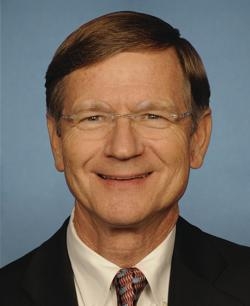Thu, Mar 21, 2013
House Science, Space, And Technology Committee Reviews Government Efforts To Protect Earth
The House Science, Space, and Technology Committee held a hearing Tuesday titled "Threats from Space: A Review of U.S. Government Efforts to Track and Mitigate Asteroids and Meteors." The hearing is the first in a two-part series on what the U.S. is doing to track and monitor Near Earth Objects (NEO) that pose a threat to the planet. It comes one month after an asteroid passed the earth and a meteor exploded over the skies in Russia on the same day.

“The meteor that struck Russia was estimated to be 17 meters, and wasn’t tracked at all," said committee chair Lamar Smith (R-TX) (pictured). "The smaller they are, the harder they are to spot, and yet they can be life-threatening. Some space challenges require innovation, commitment and diligence. This is one of them.
“Examining and exploring ways to protect the Earth from asteroids and meteors is a priority for the American people and should be a priority for government. We were fortunate that the events of last month were simply an interesting coincidence rather than a catastrophe. And this Committee will strive to continue to lead in this area.”
On February 15, 2013, an unforeseen meteor exploded above Russia, releasing the equivalent of about 20 times the explosive energy of an atomic bomb. The blast injured nearly 1,200 people and resulted in an estimated $33 million in property damage. Until it entered our atmosphere, the Russian meteor went completely undetected. On the same day, a larger asteroid discovered by amateur astronomers and tracked closely by NASA passed safely by the Earth, but within the orbital belt of weather satellites.
Tuesday’s hearing provided an overview of the U.S. government’s plans and programs to track, classify and mitigate the threat of NEOs. Witnesses estimated that between 13,000 and 20,000 objects exist that are over 140 meters and considered “near Earth.” Scientists currently have knowledge of and track around 10 percent. In order to improve on these capabilities, witnesses discussed the need for better international collaboration and more space-borne telescopes to track NEOs.
A second hearing is planned for April to address international, commercial private sector and philanthropic initiatives to survey the sky for asteroids and comets.
More News
Aero Linx: International Federation of Airworthiness (IFA) We aim to be the most internationally respected independent authority on the subject of Airworthiness. IFA uniquely combi>[...]
Ultrahigh Frequency (UHF) The frequency band between 300 and 3,000 MHz. The bank of radio frequencies used for military air/ground voice communications. In some instances this may >[...]
A Few Questions AND Answers To Help You Get MORE Out of ANN! 1) I forgot my password. How do I find it? 1) Easy... click here and give us your e-mail address--we'll send it to you >[...]
From 2019 (YouTube Edition): Learning To Paint Without Getting Any On Your Hands PPG's Aerospace Coatings Academy is a tool designed to teach everything one needs to know about all>[...]
Also: Sustainable Aircraft Test Put Aside, More Falcon 9 Ops, Wyoming ANG Rescue, Oreo Cookie Into Orbit Joby Aviation has reason to celebrate, recently completing its first full t>[...]
 ANN's Daily Aero-Linx (05.06.25)
ANN's Daily Aero-Linx (05.06.25) ANN's Daily Aero-Term (05.06.25): Ultrahigh Frequency (UHF)
ANN's Daily Aero-Term (05.06.25): Ultrahigh Frequency (UHF) ANN FAQ: Q&A 101
ANN FAQ: Q&A 101 Classic Aero-TV: Virtual Reality Painting--PPG Leverages Technology for Training
Classic Aero-TV: Virtual Reality Painting--PPG Leverages Technology for Training Airborne 05.02.25: Joby Crewed Milestone, Diamond Club, Canadian Pilot Insurance
Airborne 05.02.25: Joby Crewed Milestone, Diamond Club, Canadian Pilot Insurance



